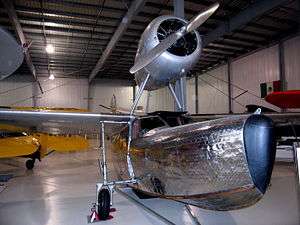Fleetwings Sea Bird
| Fleetwings Sea Bird | |
|---|---|
 | |
| F-401 prototype, Golden Wings Museum, Blaine, Minnesota | |
| Role | Amphibious utility aircraft |
| Manufacturer | Fleetwings |
| Designer | James C. Reddig |
| First flight | 1936 |
| Number built | 1 prototype; 5 production |
The Fleetwings Sea Bird (or Seabird) was an American-built amphibious aircraft of the 1930s.
Design and production
The Sea Bird was an amphibious utility aircraft designed in 1934-5 by James C. Reddig for Fleetwings, Inc., of Bristol, PA. While the aircraft's basic configuration had a precedent in the design of the Loening "Monoduck" developed by the Grover Loening Aircraft Company as a personal aircraft for Mr. Loening (for whom Reddig worked from 1929-1933), the Sea Bird was unusual because of its construction from spot-welded stainless steel. It was a high-wing, wire-braced monoplane with its engine housed in a nacelle mounted above the wings on struts. The pilot and passengers sat in a fully enclosed cabin. Fleetwings initially planned to manufacture 50 production units, but at a price approaching $25,000 during the Depression, there proved to be no sustainable market.
Operational history
The Sea Bird found use with private pilot owners and saw service with the oil support industry in Louisiana including operation by J. Ray McDermott.
Variants
- F-4 Sea Bird - 4-seat prototype (1 built)
- F-5 Sea Bird - 5-seat production aircraft (5 built)
Specifications
Data from Specifications of American Airplanes[1]
General characteristics
- Crew: 1
- Capacity: 3 passengers
- Length: 31 ft 5 in (9.58 m)
- Wingspan: 40 ft 6 in (12.34 m)
- Height: 12 ft 6 in (3.81 m)
- Wing area: 235 sq ft (21.8 m2)
- Empty weight: 2,320 lb (1,052 kg)
- Gross weight: 3,450 lb (1,565 kg)
- Fuel capacity: 52 US gal (43 imp gal; 200 L)
- Powerplant: 1 × Jacobs L-5 7-cyliner air-cooler radial engine, 285 hp (213 kW)
Performance
- Maximum speed: 150 mph (241 km/h; 130 kn) at sea level
- Cruise speed: 133 mph (214 km/h; 116 kn)
- Range: 400 mi (348 nmi; 644 km)
- Service ceiling: 15,000 ft (4,600 m)
- Rate of climb: 900 ft/min (4.6 m/s)
References
| Wikimedia Commons has media related to Fleetwings Sea Bird. |
- ↑ Aviation April 1937, pp. 70–71.
- "Specifications of American Airplanes". Aviation. Vol. 36 no. 4. April 1937. pp. 66–71. (Registration required (help)).
- Taylor, Michael J. H. (1989). Jane's Encyclopedia of Aviation. London: Studio Editions. p. 392. ISBN 0-7106-0710-5.
- "A Shot-Welded Stainless Steel Amphibian". Flight: 424. 22 October 1936. Retrieved 2008-03-19.
- aerofiles.com